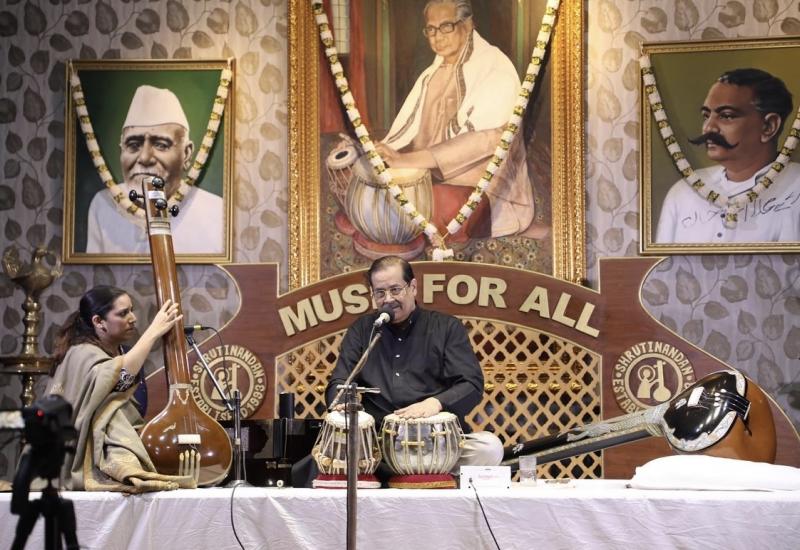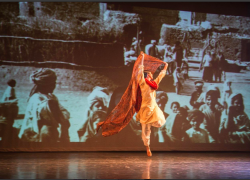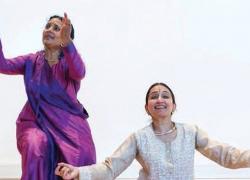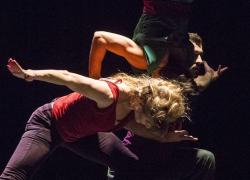The Making of MEHEK – Aditi Mangaldas
Kathak dancer and choreographer Aditi Mangaldas has established an international reputation for excellence of technique and aesthetics and for breaking new ground in the themes she has tackled, from feminine desire to violence against women. In MEHEK she teams up with friend and fellow dancer Aakash Odedra to create the narrative of the relationship between an older woman and a young man.
The performance of MEHEK, which premiered in Abu Dhabi in February 2024, is coming to Sadler’s Wells Dance House on 12 and 13 April. Here Aditi Mangaldas talks to Sanjeevini Dutta on the making of MEHEK.
1. Last Autumn 2023 you presented FORBIDDEN also at Sadler’s Wells. You must already have been working on MEHEK?
How did the idea of a duet between yourself and Aakash Odedra come to you both and how long have you been working on it?
The entire process of the idea of MEHEK was quite serendipitous. As the pandemic was waning, I had called Aakash and told him that I was ready to come and teach at his institution; t which point he asked whether I would be happy to do a duet with him. I said yes immediately and we decided to touch base two days later. When we spoke, we realised that we both had the same idea – that of a love story between an older woman and a younger man! At that moment MEHEK was born. This was in early September 2021 and since then we were creating it over periods of rehearsals in India and the UK, till the premiere in Abu Dhabi on 7 February 2024.
2. Physical contact has not existed in Indian dance (as it is primarily a solo form), so did it come easily or did you have to overcome an inhibition?
Yes absolutely, in Indian classical dance, touch is something very alien. However, I have explored this in some of my contemporary works based on kathak and so personally I was quite comfortable with it. Aakash has trained in contemporary dance, so touch has been a part of his training. Both Aakash and I have great regard, admiration and respect for each other’s work, so there was a beautiful coming together and a very positive energy and chemistry while we were creating MEHEK.
3. Without a text/narrative to draw upon, how did you build a seventy-minute show?
The subject matter of MEHEK is itself so powerful that within it are multiple narratives that one has experienced, seen, heard or read about in society. These observed and felt experiences were very compelling narratives themselves. Adding to that were the inputs of all the collaborators. As well as their thought process for the development of the narrative, they brought independent dimensions into this work through lights, music, dramaturgy and the scenography. So, it was collaborative process that built the narrative. Words were not really necessary – though we do use two music compositions which talk about how love and passion changes the landscape of our beings - saat samandar dil de andar, dil se lehar uthavangi and aaja yaar de didar.
4. Please tell us how the dramaturg Karthika Nair helped to tease out the drama. Could you give us a couple of specific examples?
It was such an amazing experience to have Karthika Nair as a dramaturg. In one of the initial explorations of MEHEK she asked pertinent questions – not only of Aakash and me but also of the musicians, “What is the fragrance of love? What is the colour of love? What is the place that you think of when you think of love?” Such introspective questions had a flowering effect on the choreography. At every stage, Karthika’s observations, comments and suggestions were profound and so relevant. At times when we got stuck in the choreographic process, suddenly a door was opened by just a question that she posed to us.
5. The role of music (Nicki Wells) and lighting (Fabianna Piccioli) plays a big part in your productions. Could you say something about the sound score and lighting in MEHEK?
Both Nicki Wells and Fabiana Piccioli are extraordinary artists and I have had the privilege of working with both of them before. Nicki has a deep understanding of Hindustani classical music as well as world music. There are three Hindustani classical musicians in the wor:; two percussionists (tabla and pakhawaj) and one vocalist – along with Nicki as a vocalist herself. The challenge for her was to find a beautiful synthesis of one into the other, so that the eventual musical score was universal.
Fabiana Piccioli is an amazing designer. Her ideas and suggestions of light design transformed MEHEK. The lights transport you to the depths of an ocean or take you soaring high in the sky! The lighting, along with the outstanding set design by Tina Tzoka, itself becomes a love story. It was an amazing experience to work with these brilliant collaborators.
_
6. The Geeta Govinda astapadi also explore desire and intimacy as themes in Indian dance. What further insights do you think that your work brings?
The objective of MEHEK is not just to explore desire and intimacy. It is to subtly convey the double standards and bias that society has. MEHEK is very different from my earlier solo FORBIDDEN, even though both works address taboos in society. FORBIDDEN is both ferocious and innocent simultaneously – whereas MEHEK is poetic and beautiful and yet holds up a mirror to society without being preachy. Love, desire and intimacy can be explored in multiple different ways just as it is in the Geeta Govinda and many of our ancient texts. But MEHEK is not just about these explorations, it is also about questioning social norms.
7. Is there anything else that you would like to add about the performance?
I would like to quote a guest who came to the première in Abu Dhabi…
“Right from the choreography of the dance sequences and the storytelling, the silences and spaces, just the right degree of restraint and such a haunting repertoire of music, all coalesced to offer a truly transcendental experience.”
In this world where there is so much strife, especially at this very moment, artists in some way have to hold on to and share the belief that life essentially is beautiful if we all find the humanity within us.
_______________________________________________________
Aditi Mangaldas is a leading dancer and choreographer in the classical Indian dance form of Kathak. With extensive training under the leading gurus of Kathak, Shrimati Kumudini Lakhia and Pandit Birju Maharaj, Aditi is today recognised for her artistry, technique, eloquence and characteristic energy that mark every performance. Besides dancing and choreographing classical productions, both solo and group, she has broken new ground by using her knowledge and experience of Kathak as a springboard to evolve a contemporary dance vocabulary, infused with the spirit of the classical.
Considered a maverick in India, she has consistently broken ground, unafraid to confront social and present-day concerns. Celebrated around the world for the startling richness and intricacy of her dance and choreography, she was nominated in the category of outstanding performance (classical) by the National Dance Critics Circle awards – 2017 in the UK. She was awarded the Gujarat Sangeet Natak Academy award, India 2007 as well as the National Sangeet Natak Akademi award, India 2013, that due to compelling reasons, she declined. She has won much critical acclaim in major dance festivals across the world.
Aditi heads the Aditi Mangaldas Dance Company – The Drishtikon Dance Foundation (www.aditimangaldasdance.com)


















